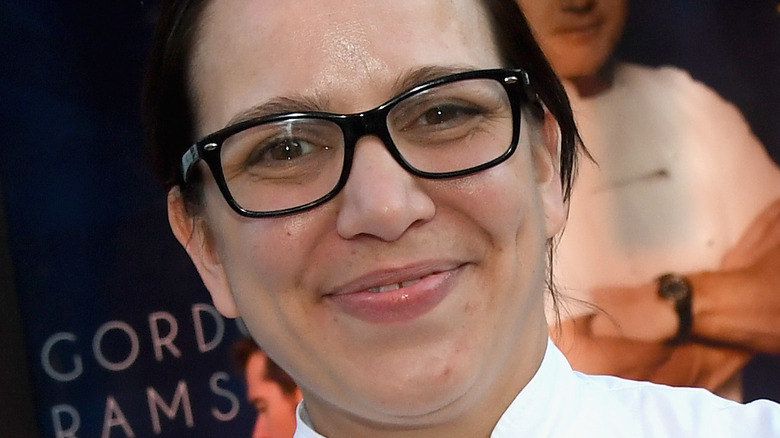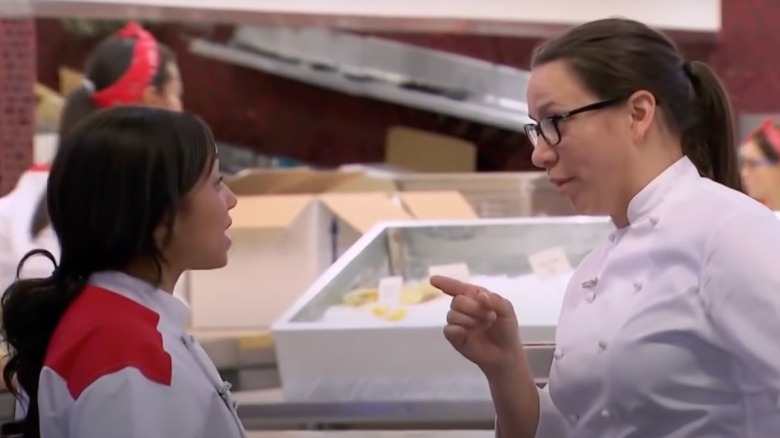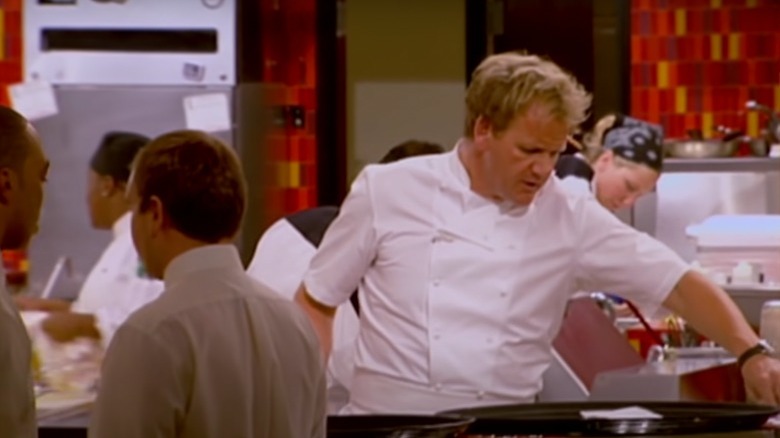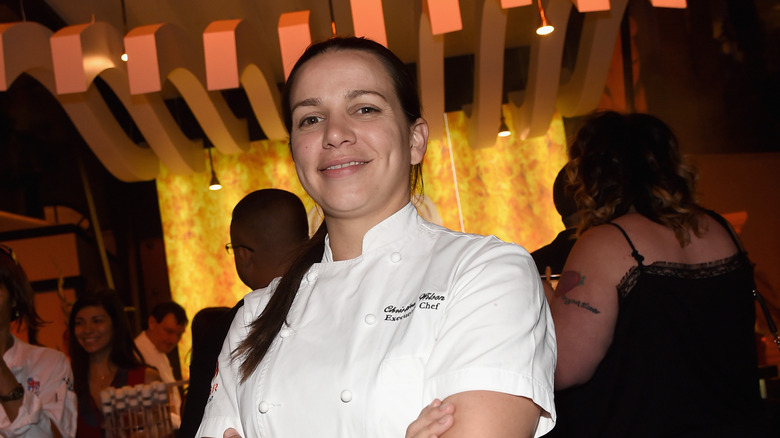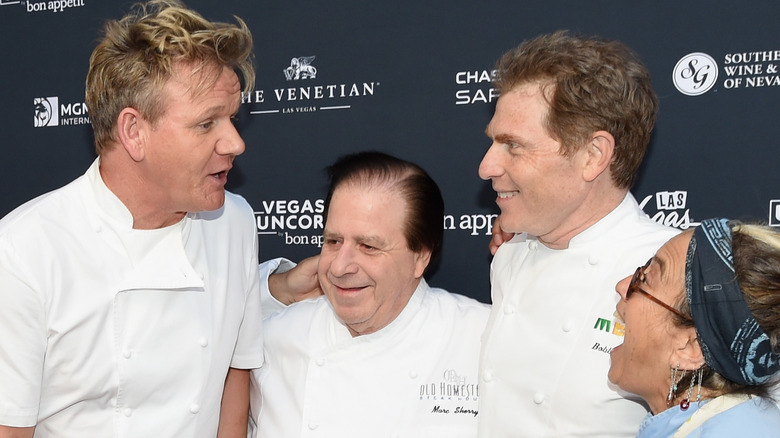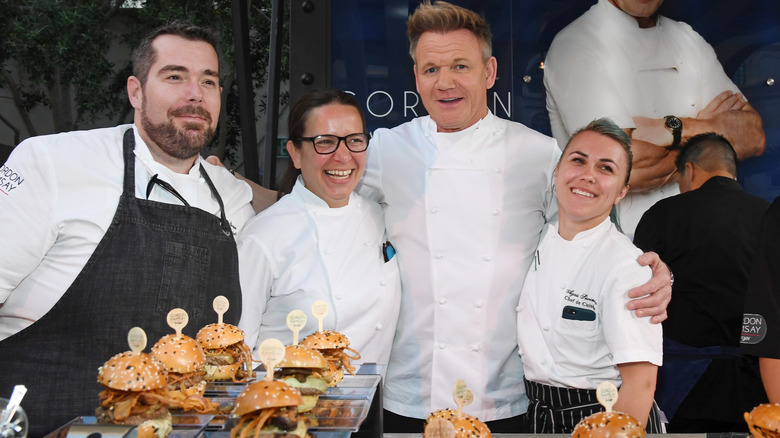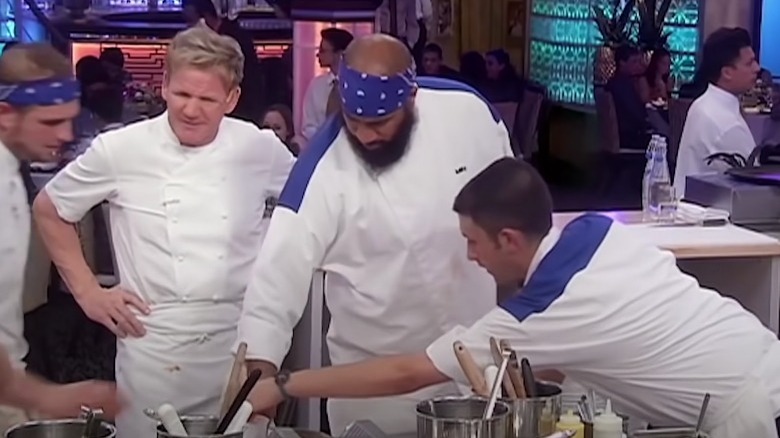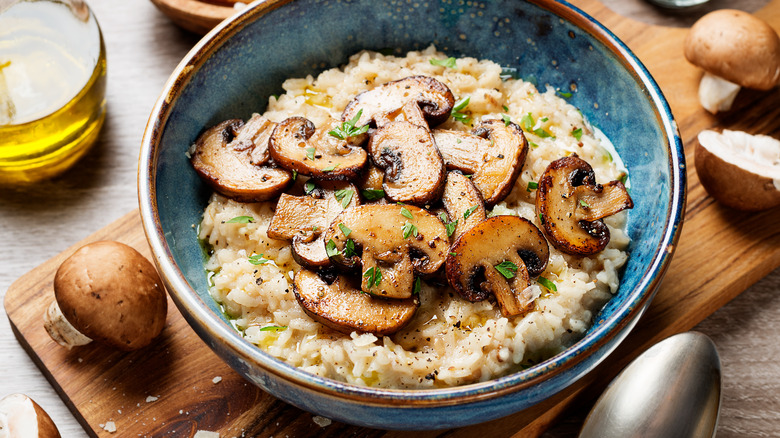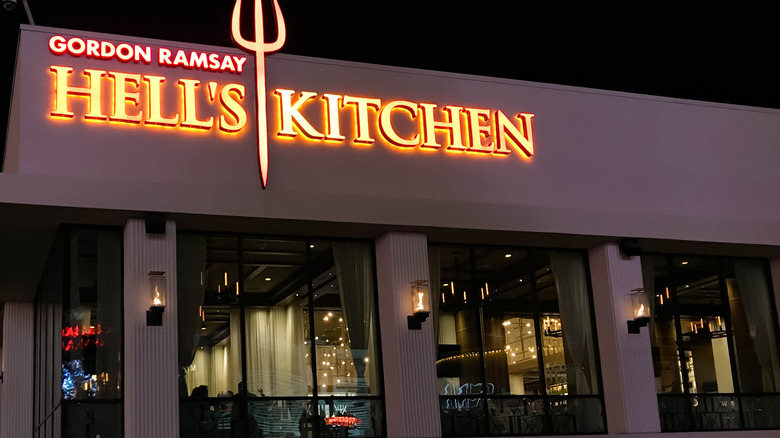Christina Wilson Talks Hell's Kitchen And Gordon Ramsay's Newest Restaurant - Exclusive Interview
Chef Christina Wilson doesn't relish administering punishments when the Red Team loses on "Hell's Kitchen." Since winning Season 10 of Gordon Ramsay's notoriously brutal competition over a decade ago, the chef has become both V.P. of Culinary for Gordon Ramsay North America and a relentless taskmaster on the iconic show — and not one to shy away from making her contestants repent. Wilson, however, enjoys other parts of shooting more. Take Ramsay's penchant for stealing the art department's scooters, for example.
Wilson told Tasting Table that she also uses "Hell's Kitchen" shoots to get Ramsay to taste test dishes for his portfolio of U.S. establishments. The chef is particularly excited about local menu items that she and the team have planned for the "Hell's Kitchen" restaurant set to open in D.C. this fall. Naturally, its menu also includes beef Wellington and risotto — two dishes you'll be able to tackle at home after reading Wilson's tips. Stay tuned for these, her "Hell's Kitchen" Season 21 reflections, and the inside scoop on Gordon Ramsay and Bobby Flay's (probably playful?) rivalry.
The worst punishment Christina Wilson has doled out on Hell's Kitchen
You once remarked that one of the best things about a less-experienced chef is that they haven't picked up as many bad habits yet. What are the worst habits that you've seen competitors making on "Hell's Kitchen"?
Oh my God, the worst. How do I rank them? ... One that's the most heartbreaking is the way they treat their knives. Every contestant gets this beautiful set of J.A. Henckels Zwilling knives. I still have mine; I still use mine, and they're ... 11 years old, because we've filmed in 2011.
Not taking care of their knives leads to poor knife cuts and poor technique. That's the one that probably drives me the most nuts every single season ... People don't know very basic knife cuts or butchery techniques. If they're taught wrong and that's what they use as their foundation to build on, they're already going to be shaky. We try to take some time in the first week of the season and undo some of those things that we spot and see.
You are also famously tough when it comes to punishment on "Hell's Kitchen"!
They make me do that. Ask my nieces!
What's your most vivid punishment memory?
Probably on the "All Star" season — there is this one incident where they had to eat, I think it was a seafood creme brulee ... something really not nice. I caught wind that Elise hadn't been eating hers, and I — for the record, jokingly — told the producers, "I'm going to go smell their breath. I'll figure it out. I'll see if she'll lie to my face." I went out, and she was lying and ... her teammates were shaking. I was like, "Did she eat it?" They're like, "No, no, no," letting me know through their nonverbal communication that she had, in fact, not had any.
I lined them up, and I made them all let me smell their breath. Honestly, it was to make the day of the producer because it's very intense being on set. I did not expect that to make the edit. I thought we were having fun. That's one that sticks out in my head — [firstly], because that lunch was so bad. Also, I definitely did stick my nose into the mouth of another grown chef, so that's a touch awkward. It ended up being [a] punishment for me.
Inside Hell's Kitchen Season 21's first dinner service
What sticks out to you most about this season compared to other seasons? If we go back to the first dinner service this season, which is notoriously the hardest, what's going through your mind?
[With] the talent across the board, the 40s and 20-somethings, there's some really great talent. The two people that finish second and third — once the season's over, I will absolutely be calling them to see if they're interested in a job with us ... There's an incredible depth of talent this year, which made the challenges a lot of fun. Dinner service was hard, as you said, notoriously. The first one is, a lot of times, the bumpiest — no big surprise that it's a bit bumpy this season too.
The 20-somethings ... really surprised me more than I thought they would ... I was really shocked at how innovative some of the food was. It progressed throughout the competition ... but they absolutely did get their butt kicked in dinner service. These kids came out of culinary school, or whatever their training program was, into a pandemic, so they didn't necessarily have that line cook experience or that live restaurant experience that the 40-somethings had.
For dinner service, the 40s definitely had a leg up, but the 20s, man, they were collectively not as individually focused. They were a little bit more team focused. You'll see, surprisingly, a lot of success out of them early on, too.
The time Christina Wilson questioned her Hell's Kitchen journey
During your seasons of "Hell's Kitchen," you had trouble cooking the beef Wellington for the first time. What mistake did you make?
Yes ... The puff pastry wasn't rolled out. The Wellingtons kept going up and the beef itself was cooked nicely, but the dough was still wrong ... the dough wasn't cooking at the same rate as the beef. That's not something that [you notice] until you slice it, so you don't know until it's already too late ... Trust me, that was such a rough first night. I was like, "S***. I'm not... Oh, my God, what am I even doing here?"
I'm glad I had the opportunity to bounce back, but that's what happened ... [with] the beef Wellington, it's patience and it's time. It's pretty much a two-day process. If you go for it as your first attempt and you're only doing it in one day, it's not going to be all the way right. It'll be good, but it won't be all the way right. You really want to give yourself the time to prep all the ingredients and have a good setup.
What makes Ramsay's beef Wellington stand out?
Each component, we approach a touch differently. The [secret is] the mushroom mix that we use. We use port wine to de-glaze, [which] has some nice aromatics in there. He also uses a crepe. Not everybody puts a crepe as an extra protective layer from the beef juices getting to the pastry. English mustard [is] brushed on. A lot of people use Dijon, which is also really good, but the English mustard has a little bit more of a bite. The crepe is probably one of the extra steps that really helps protect it. It's a whole extra step ... You have to make the crepes, let them cool, and then it's an extra step in the rolling process, too.
The pranks Gordon Ramsay plays on set
When you were celebrating an anniversary of a restaurant once, Gordon Ramsay went undercover and dressed up as a waiter. What is his most memorable prank and what have you done to prank him back?
I haven't pranked him back yet. I had reached out to Twitter, "Help me, please, figure out how to prank this man back." I do still need to figure something out. That was a fun one. Selfishly, it's probably my favorite because he got me. I love when people get to see that playful side of Gordon...
He had done it to another one of the chefs in the group. Her name is Maria Tampakis. She lives up in New York but had worked for Gordon over in London for ages, helped open a handful of restaurants, [and is a] super talented young lady. He went into her culinary school where she was an instructor and pretended to be a student and shocked the pants off of her, too...
He's like that on set too. I've seen him. Our TV set, it's usually in an old IKEA or Costco ... so people use scooters quite a bit to get around, or little golf carts. He'll take it and park it somewhere obscure and not tell anyone and then come back. Nobody knows that it was Gordon and nobody knows where the golf cart is now. You'll hear the art department all walking, begging where the golf cart is and a few minutes later you'll see Gordon in the corner laughing ...
That prank at Steak's five-year anniversary, that was a good one. He got me. I was trying so hard to keep my cool. He pulled the plug at the right time because I was about to go have a chat with the waiter myself.
The family side of Gordon Ramsay
On The Gram, you once posted a pic of you, Ramsay and Guy Fieri playing Heads Up with the caption, "My boss is so much cooler than you'll ever know." What was going on there?
They have a very playful relationship. The one that Gordon tends to be more competitive with is Bobby Flay, who also happened to be there that night, but he was definitely not at our table playing Heads Up. [It's] a very friendly rivalry between the two of them.
That night, we were doing a benefit dinner in Las Vegas. We were at Caesar's Palace raising money for first responders and all the celebrity chefs that have restaurants within the Caesar's portfolio were there to help raise money and awareness ... They had a couple entertainers and some other bits throughout the programming and the chefs were the tail end of it. Gordon was the encore part of it all.
We were being held in the screen room, and two of Gordon's daughters were there, Holly and Tilly. He is an absolute puddle when he's around his kids. There's the "Hell's Kitchen," "Kitchen Nightmares" side of Gordon. There's the "MasterChef Junior" side of Gordon. There's a "Nat Geo" [side], where he's adventurous and the student, and then there's the family man.
It will melt you to see him with his kids and his wife. It's unbelievable. He's such a family man. Two of his daughters were there that night. We were trying to keep them entertained, and we were playing a game of Heads Up. Gordon was getting his butt kicked by his teenage daughters, which was fun to see.
The time Gordon Ramsay marched into Bobby Flay's LA restaurant
You mentioned that Gordon and Bobby Flay have a rivalry. What's the number-one time you've seen them butt heads?
The time that stands out the most must have been [around 2016 [or 2017]. We were in Las Vegas at Caesar's Palace. Gordon has two restaurants there. Pub & Grill is right next door to what used to be Mesa Grill by Bobby Flay. Gordon had been challenging Bobby. He wanted to do a cook-off in the legendary Muhammad Ali boxing ring. Gordon would bring his sous chefs and chef team, Bobby [would] bring his, [and] they'll do it for charity.
It was on-and-off for a couple of years and they couldn't really negotiate the terms ... Gordon called him out any time he was on a late-night talk show or anytime he was doing an interview. He would find a way to bring Bobby into it.
We were at Pub & Grill ... Gordon was coming in to do a tasting, say hi to the team, and spend some time with the chefs. It was when Facebook Live had just come out and it used to be that it had to be a 10-minute long video ... This was the weekend he was going to do some Facebook Live videos in Vegas. I have my knife roll because we had been putting on a tasting for him, and ... he sees my knife bag. He's like, "Is that yours?" I was like, "Yeah." He looks at his assistant, Justin, and I can see they have something brewing. I'm not quite sure what it is.
He is like, "I'm going to borrow this for a minute." I was like, "Oh, s***. Here we go" ... I see Justin turn his camera on. I could see on the screen that it's Facebook Live. All of a sudden, Gordon's walking out the door and he goes, "Come on." He walked into Bobby Flay's restaurant, walks in the kitchen, he's begging, "Where's Bobby? Where's Bobby? We're supposed to have this cookoff." He's trying to call him on the phone during this Facebook Live. He calls Nobu, and all the other big chefs. He is making this big deal. Then, he's sitting down in Bobby Flay's restaurant, signing his cookbooks for the patrons who were there. That was interesting.
Right at the 10 minute 1 second mark, they turn it off. He leaves, and the PR team was 90 seconds behind. They had come rushing down [going], "What's going on?" It was all in good fun. That was probably one of my favorite ones. He marched right over, had my knives, pretended he was meant to be cooking against Bobby that day.
Gordon Ramsay's burger-to-bun ratio revealed
In one of your test kitchens, you were recently cooking up some new burgers. How do you come up with original burger variations?
Gordon opened his first burger restaurant in Vegas in December of 2012 — coming up on 10 years here. It was probably about six or nine months worth of research on the sesame seeded brioche bun, and then the actual patty itself: what the blend was going to be, what the fat ratio was going to be. Then, we make sure the meat-to-bun ratio is correct.
That's our pillar of where we start with every burger. From there, sometimes they're inspired by trends, sometimes they're inspired by regional places. We have, currently in Chicago Burger, we're running a monthly burger that we call the London Hot, a play on a Nashville Hot. We use a bit of a different batter and it's not as spicy as what they put on in Nashville, but it's inspired by [it].
We'll look at trends, we look at different regions, and then look at holidays. For instance, coming up in November, we'll have a burger that we call a turducken burger. It'll be a turkey patty, duck confit pulled on top, and then a chicken egg. You have all three of those with some other dressing.
For people looking to master their burgers at home, what is the bun-to-meat ratio we should be aiming for?
It has to make sense for you. If your burger patty, for instance, is only four ounces, you're not going to have a four-ounce bun also. It's going to be too much bread to the patty. You'd want to bump that to six ounces or eight ounces of meat or get a smaller bun. A lot of it is personal preference. too. I like a good brioche bun when I'm creating for the restaurants. If I'm cooking in my backyard, Martin's potato roll or Hawaiian roll is what I go for. There's a lot of personal preference, but ... there's not a perfect ratio necessarily. We use an eight-ounce patty to a four-ounce bun in our restaurants. That's a little bit of a guideline.
Christina Wilson says its still hard to say no to Gordon Ramsay
Risotto is one of your favorite dishes to cook. It's also one of the more common dishes to mess up during dinner service. What's your number one piece of advice to the Red Team when they're tackling it?
It's patience. It's about checking your risotto ahead of service. You do a tester, so you'd know, "Okay, it's going to be a six-minute pickup today," or, "It's going to be an eight-minute pickup today." Then, you have to remember that and drive the rest of the team to work towards those honest times. It's about tasting the whole way through. The more he pushes, people get frantic. It's hard. I've been in their shoes.
Even as a sous chef, as his vice president on culinary, it's hard to look that man in the eye sometimes and say, "No, Chef, I can't give this to you right now. I need another week," or, "This is going to take four more minutes and there's nothing I can do about it." People want to please him so badly, like, "Okay, Chef. Fine. Two minutes," and there's no chance that's going to be done in two minutes. You have to know your product and stand true to the times that you're calling and have the patience. It's much better to do it right one time and take the extra few minutes.
The key to making mouthwatering risotto
If we're making risotto at home, is there any technique or ingredient that you could recommend adding or implementing?
Yeah, and this is without Gordon in your kitchen yelling at you. One of the things that's super helpful is to toast the rice first. Start with a dry pan. Let it get warm on medium-low heat and put your rice in there. You don't want it to turn brown; you want it to be warm to the touch. You have to move it around a bit. That's going to help draw some of the starch out.
When I make it at home, I start in a dry pan and toast the rice for a little bit. I use shallot instead of red onion. It's not as stringent, almost a little bit sweeter. I'll put about a tablespoon of shallot into a dry pan and let it sweat out. It doesn't take very long. You don't want to brown them at all. De-glaze with white wine. Let all the alcohol evaporate, and then start feeding in whatever stock you're using — either vegetable stock, chicken stock, [or] seafood stock, depending on the style of risotto.
You have to be really patient. Feed that liquid in a little bit at a time. As it absorbs, you add a little more. [It's a] 20, 25-minute process. Use a rubber spatula or a wooden spoon. It won't conduct heat. It won't break your rice. A lot of people are used to using metal or tongs or something, but you want to be really gentle with it. By toasting the rice first, you'll start to see then as you're adding the liquid, it'll almost get creamy without having to add [anything].
You shouldn't ever add heavy cream or anything like that, but a little bit of mascarpone at the end to finish — I like that instead of butter. It gives it [a] nice, glossy, silky look and mouth feel and then gives you a little extra fat in there to help bind everything together.
Inside the new Hell's Kitchen restaurant in DC
You are heavily involved in opening a Hell's Kitchen restaurant in DC at the moment. Can you give us a peek into any unique menu items, maybe regional menu items in that restaurant?
For DC specifically, we worked on a really great octopus dish, which is beautiful and delicious. That's one that we don't have on some of the other Hell's Kitchen menus. The great thing about DC is it's got such an international market, so we're able to gently lean into some Mediterranean food, some more Japanese-inspired food, some more Thai-inspired food, and a few Mexican, Latin-inspired dishes on there as well.
[You might see] a side of elote corn, some of the pizzas that we go for, and then the style that we do the chicken breasts. We have our tried and trues — risottos, scallops, Wellington, and sticky toffee pudding. They'll always be the bulk of the menu. We like to have some fun with the other dishes there.
"Hell's Kitchen" Season 21 premieres tonight at 8 p.m. ET 29 on FOX.
This interview has been edited for clarity.
